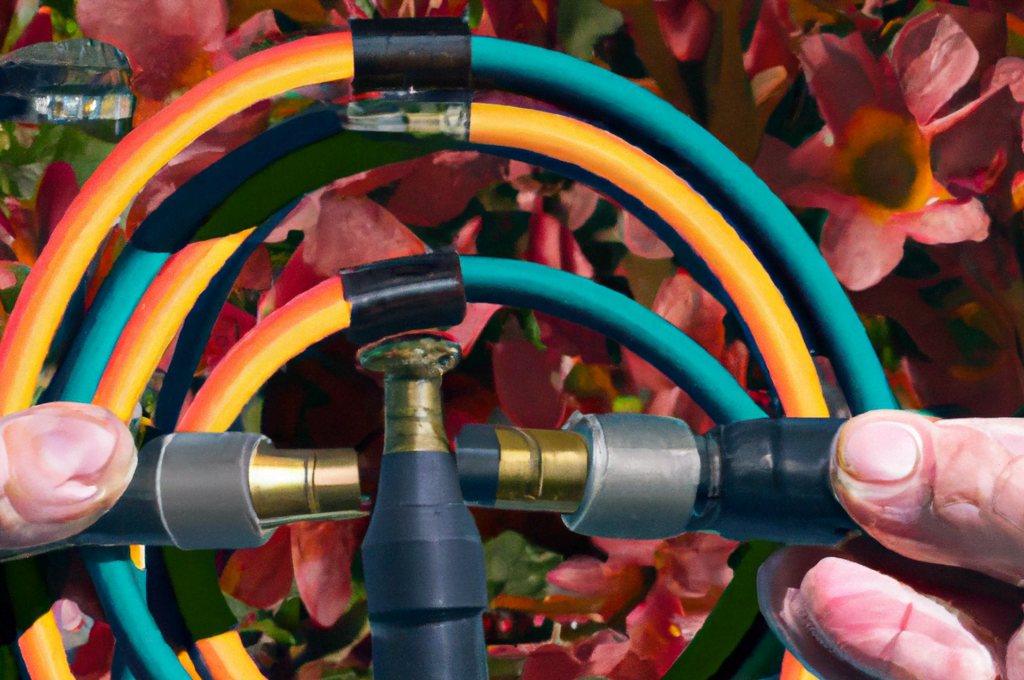Do you struggle with selecting the right garden hose size and fittings? It’s important to get it right, as proper water flow is essential for maintaining your outdoor spaces. But with so many options available, it can be confusing to know where to start.
That’s where our tips and tricks for mastering garden hose size come in handy. In this article, we’ll guide you through the process of selecting the right garden hose size and fittings. We’ll cover standard garden hose sizes, how to accurately measure the inner diameter of the rubber hose opening, and why understanding the difference between male and female connections is important.
With our guide, you’ll be able to confidently choose the right garden hose size and fittings, ensuring proper water flow and the safety of your outdoor spaces.
Quick Summary
- The standard sizes for garden hoses are 1/2 inch, 5/8 inch, 3/4 inch, and 1 inch, with 5/8 inch being the most common.
- To measure the diameter of a garden hose, measure the inner diameter of the rubber hose opening, not the metal ends, and use wooden dowels or metal drill bits for the most accurate measurement.
- Garden hose fittings come with either male or female connections, and the standard size for fittings is 5/8 inch. Look for GHT, MHT, or FHT labels for the appropriate thread type.
- Proper measurement and selection of garden hose size and fittings is important for ensuring proper water flow and maintaining outdoor spaces.
Sizes and Fittings
If you’re looking to master garden hose size, you’ll want to pay attention to the sizes and fittings available. The standard garden hose sizes are 1/2 inch, 5/8 inch, 3/4 inch, and 1 inch.
To ensure proper water flow, it’s essential to measure the inner diameter of the rubber hose opening using measuring tools such as wooden dowels or metal drill bits. Common hose problems such as leaks can often be fixed by replacing broken or leaking fittings, which come in either male or female connections.
It’s important to understand the difference between male and female connections when selecting the right size fittings for your garden hose. Threads on the outside are male fittings, while threads on the inside are female.
The standard size for garden hose fittings is 5/8 inch, and you can look for GHT label for garden hose thread, MHT or FHT for male and female hose thread fitting. By mastering garden hose sizes and fittings, you can ensure proper water flow and save money by fixing common hose problems.
Can Microgreens be Grown and Cultivated Using a Garden Hose?
Microgreens can indeed be grown and cultivated using a garden hose. This method offers numerous benefits of microgreens, such as convenience and water efficiency. By providing a controlled source of water, the garden hose makes it easier to maintain the optimal moisture level required for microgreen growth. Additionally, it allows for precise watering, preventing overwatering and eliminating the risk of soil compaction.
Accurate Measurement Methods
To measure the diameter of your garden hose accurately, it’s important to disconnect it from the faucet and remove any non-original fittings. This will ensure that you’re measuring the inner diameter of the rubber hose opening, which is the most crucial measurement for determining proper water flow.
For the most precise measurement, you can use household items such as wooden dowels or metal drill bits. Simply insert the dowel or bit into the hose opening and measure the diameter.
One common mistake in measuring garden hose size is measuring the metal ends of the hose. This can lead to inaccurate measurements and improper fittings. It’s also important to double-check your measurements by measuring diagonally across the end of the hose.
With these tips and tricks, you can accurately measure your garden hose diameter and select the right size fittings for optimal water flow.
Importance of Understanding Connections
Understanding the difference between male and female connections for hose fittings is crucial in selecting the right size fittings for your garden hose. Male fittings have threads on the outside, while female fittings have threads on the inside. When selecting fittings, it’s important to ensure that the thread types match.
Different types of hoses may require different fittings, so it’s important to know what type of hose you have before purchasing fittings. For example, a soaker hose may require different fittings than a regular garden hose.
Knowing the correct fittings to use can help prevent leaks and ensure proper water flow. Make sure to double-check your measurements and thread types before purchasing fittings to ensure a proper fit.
Frequently Asked Questions
Can I use a larger diameter hose for better water flow?
Using a larger hose can increase water flow and improve water pressure. However, it’s important to make sure your fittings match the larger diameter and to not exceed the recommended pressure for your equipment. Safety first!
How do I know if my hose needs to be replaced?
To determine if your hose needs to be replaced, look for signs of wear such as cracks, leaks, or kinks. A hose’s lifespan depends on the frequency of use and maintenance. Regularly inspect and replace worn hoses to prevent accidents and ensure proper water flow.
What is the difference between a soaker hose and a regular garden hose?
A soaker hose is designed to slowly release water into the soil, providing deep and consistent watering for plants. Pros include water efficiency and reduced weed growth, while cons include slower watering and potential for uneven distribution. Best for gardens and raised beds.
Can I use a garden hose for drinking water?
To ensure drinking water safety, use a hose labeled safe for potable water. Look for materials such as polyurethane or PVC, and avoid hoses made of rubber or vinyl. Always flush the hose before use.
How do I store my garden hose during the winter months?
To protect your garden hose during winter storage, disconnect it from the spigot and remove any attachments. Coil the hose loosely and store it in a dry, cool place out of direct sunlight. Consider using a hose reel or hanger for added protection.









